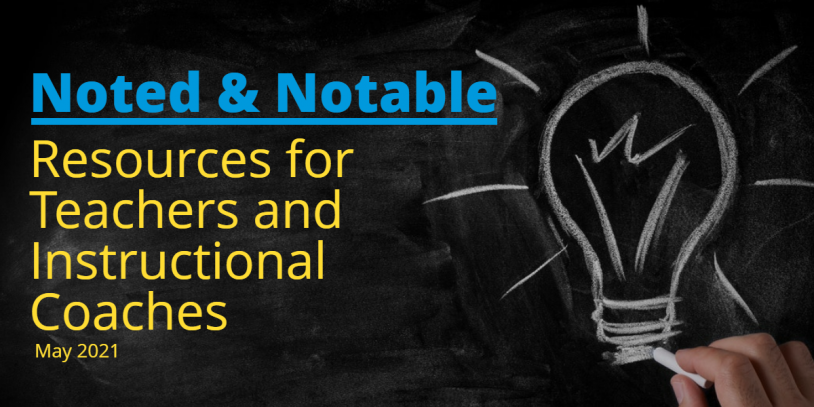Resources for Teachers and Instructional Coaches – May 2021

This May, we’re thinking about how to pave the way for stronger conversations and collaboration. We’ve been reading about facilitating conversations about anti-AAPI racism, getting teachers and principals more in sync, and fostering positive environments to make mistakes. Check out some of our favorite May reads and resources with highlights and article links!
Productive classroom conversations about anti-AAPI racism
Racism and violence against Asian Americans are not new but have seen a recent surge. Addressing this in the classroom is important to make it visible and to help students process both history and what is currently happening. Here are some specific strategies for having these hard but crucial discussions:
The first lesson (lesson and slide deck) really focused on humanizing the Atlanta victims, raising awareness about what happened there, and giving students space to make sense of what happened… Students got to see the victims visually and connect and empathize.
[W]e set norms for having difficult conversations. We borrowed these from the courageous conversation norms: I will stay engaged, I will speak my truth, I will experience discomfort, and I will expect and accept non closure.
Our students are raising the difficult questions, and we are giving them the facts and the history, and we’re telling them about the contributions of Asian Americans, and the treatment of Asian Americans in our country (additional lesson and slide deck). And all of this gives our students the background information they need to deal with the feelings [that come up around what’s happening]. These lessons are giving students tools to navigate and make sense of the truths that are difficult to reconcile, but with the message of freedom and democracy and equity.
Read more on Edutopia: Hard Classroom Conversations About Anti-Asian Racism
Reducing turnover by getting teachers and school leaders on the same page
Teachers and school or district leaders often, unknowingly, have different answers to questions about why educators love and stay in their roles and what could improve retention. This perception gap can lead to higher turnover at schools. But there are ways to mitigate the discrepancies and improve communication. Here are five strategies:
1. Be visible: Principals have to tend to their administrative duties, but it’s also crucial that teachers and students see them.
2. Open up communication: This is a two-way street. Teachers must be honest with their principals about how they are feeling. But principals must be willing to take frank feedback and constructive criticism—and then act on them.
3. Show teachers they’re valued: This can take many forms. Pay raises and bonuses are great. But so are catered meals, a food truck, gym passes, and efforts to bring levity to a year filled with challenges.
4. Find out what teachers are struggling with, and offer support.
5. Pare down paperwork: “What’s necessary?” That’s a question principals and district leaders need to ask to stanch burnout and keep teachers in the profession.
Read more on EdWeek: Principals and Teachers Don’t Always See Eye to Eye. Can Getting In Sync Reduce Turnover?
Made a mistake? Here’s how to move forward
Taking risks and making mistakes often have negative connotations. However, diving into our beliefs about why this is can help us redirect our anxiety or embarrassment to more positive and constructive responses. Here are three ways for school leaders and coaches to foster a positive mistake-making environment:
1) Take stock of the current error climate.
Before we can improve the approach to mistakes and feedback, we must consider the preconceived notions, habits, beliefs, and patterns of behavior that we all – school leaders, instructional coaches, and teachers – bring to the table. We can start by asking ourselves and our colleagues to think about our perceptions of mistakes:
- What comes to mind when you think of the word mistake?
- What is the greatest mistake you have made as a learner? How did you respond?
- What was your reaction the last time you received critical feedback from a colleague or supervisor?
- Are there particular content areas or skills that you feel sensitive about when it comes to making mistakes?
2) Strive to lead with curiosity rather than with an emphasis on correctness.
Whether it is providing feedback to teachers on their pedagogical moves or helping an educator determine how to support a child’s progress, leaders should emphasize the process of learning rather than simply landing at the “right” answer or performance.
3) Support the habit of regular professional reflection.
Maintaining space for teachers and school leaders to engage in self-examination, reflection, and peer-to-peer conversations can help them understand the extent to which their small actions and words shape the error climates of their classrooms.
Read more on Learning Forward: How to make the most of mistakes
Missed our April Notable Content? Find it here!

